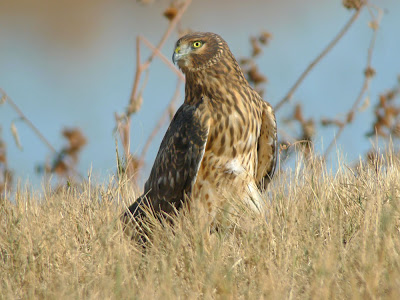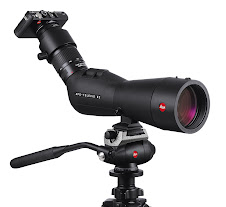The morning of November 19th started like most other fall mornings at Bosque, enjoying the lift-off of Sandhill Cranes and Snow Geese just before first light. Shortly thereafter, I was forunate to encounter an adult Prairie Falcon perched at roadside very near the visitor's center. In the early morning light, the bird was washed in a wonderful pink glow. The sun was just on the horizon at this point and it looked to be another fabulous day! The remains of a freshly plucked "Red-shafted" (Northern) Flicker lay beneath this perch. It was obvious this bird hadn't recently eaten a Flicker, as it's crop would have been bulging if it had. Clearly, someone had eaten this bird here though and an adult Prairie Falcon would certainly be a good candidate. Maybe that was last night's dinner!?!...
American Kestrel, male digiscoped with Leica APO Televid 65 mm scope & D-Lux 4 camera
American Kestrels are another common falcon species, and we saw many on this day. The male above sat on Route 1 just before entering the refuge from the North. I watched him hunting over 3 days with his bum foot. Even though he had no use of it, he seemed to be faring well. Both he and his tolerent mate (shown below) were camera hogs. They'd obviously taken up residence here knowing how many photographers visit and were hoping for extra photos! ;p
 falcon species #3 a distant, backlit Merlin in harsh light!
falcon species #3 a distant, backlit Merlin in harsh light!
Near sunset, there was time for a short trek around a portion of the loop on the refuge. I was really hoping to run into the gorgeous young Aplomado Falcon that was being reported, and in the late evening light I was fortunate enough to find it. It was amazingly cooperative again and I was able to get a number of nice photos in the warm evening light. Since, I was digiscoping, I had the advantage of incredible magnification so did not have to get too close to the bird!

immature Aplomado Falcon digiscoped through Leica APO Televid 65 mm 11/19/09
Whoa, four falcon species on the same day and the same place. With all of the prey species there where clearly a Peregrine Falcon around somewhere. I scanned the horizon in vain as the light faded. I was hoping for 5 species of falcon in one day in the US. This is a very difficult task to pull off. Sadly my Peregrine didn't show so I had to "settle" for merely enjoying 4 species (although I had 5 for the trip). Clearly though I have no room to complain it was a spectacular day with stunning views of fabulous birds.

























 After surrendering the Peregrine to the darkening sky, I hoisted my scope & tripod and slowly retired for the evening. Still enjoying the rush from the spectacle I'd enjoyed!
After surrendering the Peregrine to the darkening sky, I hoisted my scope & tripod and slowly retired for the evening. Still enjoying the rush from the spectacle I'd enjoyed!
